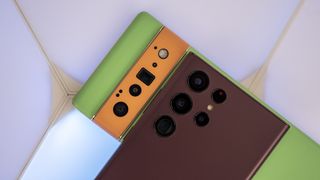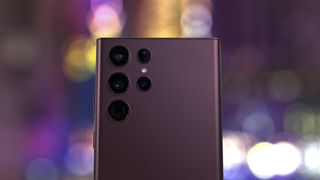Samsung Galaxy S22 Ultra vs Pixel 6 Pro: Which Nighttime camera is best?
It's Nightography vs Night Sight in an epic shootout

If you're the type of person who finds themselves taking shots in the dark, you need a powerful smartphone that can keep up. Over the years, smartphone photography has evolved considerably, harnessing the power of mobile processors to defy physics and capture more light than the human eye can see.
Phones like the Google Pixel 6 Pro and Samsung Galaxy S22 Ultra are designed with these exact scenarios in mind. They both excel in photography, which makes them two of the very best Android phones you can buy.
So I took both phones out for a night on the town and stopped to snap some photos in truly difficult lighting conditions. It's here where the computational photography prowess of each phone shines, helping to balance out photos in a way that a simple long exposure shot never could.
Which reigns supreme? The answer might surprise you in our Nightography vs Night Sight challenge.
Samsung Galaxy S22 Ultra vs Pixel 6 Pro: Main camera
Without a doubt, the main camera sensor on any phone is the one that likely gets the most use. It's the sensor used when snapping a photo of your kids or pets, the one that frames that beautiful mountain just right, and the one that captures sandcastles at the beach oh-so-perfectly.
But how about those less-than-well-lit areas? Samsung talked up its new Nightography mode a whole lot during the unveiling of the Galaxy S22 series, and the Galaxy S22 Ultra is the one that should deliver the best experience because of its new 108MP main sensor. Comparatively, Google is using last year's 50MP sensor in the Pixel 6 Pro.
But right off the bat, we can see some noticeable differences between the Pixel 6 Pro and the Galaxy S22 Ultra. These first two shots show how Google's camera software does an impressive job of pulling more light from seemingly nowhere to illuminate an otherwise dark scene.
We also see that Google's multi-frame capture algorithm works better than Samsung's at pulling in more fine detail. The bricks and the stucco siding on the building are far more defined and the words on the signs are far more readable with the Pixel 6 Pro.
Here, too, we see similar results. Google's Pixel 6 Pro delivers a brighter, cleaner, and more detailed shot in every single area when compared to the Galaxy S22 Ultra.
But when capturing a night scene, overly bright doesn't always mean better. In both of these examples, Samsung did a better job of capturing the "true" lighting in the scene. In other words, the Samsung shots are more like what the human eye sees and less like a computationally perfect photo.
Samsung also seems to prioritize balancing out the brighter parts of the photo at the expense of shadows. You'll notice that the store window on the Galaxy S22 Ultra shot looks incredibly well balanced, including the colors of the items housed within, while the windows in the Pixel 6 Pro's shot look blown out.
Meanwhile, you can see significant amounts of detail in the shadows on the Pixel 6 Pro shot while the Galaxy S22 Ultra photo is just dark on the left side and in the background.
The example below is one of many that you'll see where something went awry with Google's color science. That's because a number of color-correction algorithms work differently on the Pixel's Night Sight mode than they do in auto mode. This isn't the first shot you'll see where Google's software got the white balance wrong, and that's clearly what matters in this particular scenario.
The last example below only solidifies what we saw in the first two. Google's Pixel 6 Pro pulled out slightly more fine detail and a notable amount of additional light in this scene, whereas the Galaxy S22 Ultra's shot is moodier and is more accurate to what the human eye perceives.
Chalk this one up to preference.
Samsung Galaxy S22 Ultra vs Pixel 6 Pro: Telephoto
Samsung's famous "100x Space Zoom" from the Galaxy S21 Ultra got a big upgrade on the Galaxy S22 Ultra thanks to a pair of new telephoto sensors — one a 3x optical zoom and the other a 10x optical zoom. It's tough to think of too many situations where the Galaxy S22 Ultra wouldn't give you the best zoom quality on that market.
But the story changes a bit at night, where Samsung's night mode is restricted to a maximum of 10x zoom. Because of that, you might find yourself in a situation like the one below.
In this shot, the graffiti on the bridge was best framed at 8x viewfinder zoom. That puts it somewhere in-between the 3x and 10x physical zoom achievable by the Galaxy S22 Ultra, while it's just a bit beyond the physical zoom offered by the 4x lens on the Pixel 6 Pro.
This section of the bridge doesn't have any light on it at all, and the sensor has to rely on whatever it can gather from the surrounding area. The result is a bright, yet clearly low-resolution offer from the Galaxy S22 Ultra.
The Pixel 6 Pro produced the exact opposite shot. In this case, the Pixel 6 Pro's output is best since you can easily crank up the brightness in a few seconds by editing the photo on the phone. There's no good way to quickly fix the missing detail on the Samsung shot.
The second scenario below repeats the lighting conditions from the previous shot but increases the zoom range to the full 10x. That should activate the secondary telephoto camera but the results aren't all that different.
In particular, this one required the fine detail Google is able to piece together using its Super Res Zoom capabilities. It also closely mirrors the results I got in the telephoto section of the Galaxy S22 Ultra review and gives Google another (literally) clear win.
The two examples below highlight just how close the Pixel 6 Pro and Galaxy S22 Ultra's night modes can sometimes be. At 10x zoom, both phones are utilizing their telephoto lenses — 4x optical for the Pixel 6 Pro and 10x optical for the Galaxy S22 Ultra.
At this zoom level, the Pixel 6 Pro tends to pull in a bit more fine detail than the Galaxy S22 Ultra. While that may be surprising given that Samsung has the physical advantage of a farther optical zoom lens, Google has two other advantages that give it a slight win.
First, the Pixel 6 Pro's telephoto sensor is 48MP, while Samsung is only utilizing a 10MP sensor. That doesn't always equate to more fine detail — as is evidenced in the front camera comparison below — but Google has a secret weapon that helps: Super Res Zoom.
Google debuted this tech with the Pixel 3 in an effort to make up for the fact that it only used one camera while other companies were adding telephoto cameras. Clearly, it's still helping today, even with the inclusion of a telephoto sensor.
This last example is a bit different for one big reason: Samsung doesn't allow greater than 10x zoom while using the dedicated night mode. As you can see below, I zoomed in 10x on the Galaxy S22 Ultra then cropped the result after. This takes much more work than simply zooming in and hitting the shutter button but the results are pretty good.
Meanwhile, the Pixel 6 Pro allows a maximum of 20x zoom in either auto or Night Sight modes.
Despite not having this ability, the Galaxy S22 Ultra produced a sharper and brighter image than the Pixel 6 Pro, even if it took a little extra work to frame the shot the same way.
If you actually want to zoom in 20x or more you'll need to use auto mode to frame the shot properly. Samsung uses a different processing method when zooming in further than 10x and it takes the shot much more quickly than in night mode.
The result is an image that has less fine detail and much higher contrast but is also significantly cleaner looking than the zoomed in night mode shot.
Samsung Galaxy S22 Ultra vs Pixel 6 Pro: Ultra-wide angle
Samsung has long preferred wider-angle lenses for its rear cameras, while Google tends to trend narrower. The angle difference between the two phones isn't worth spending too much time on, but it means the Galaxy S22 Ultra's camera will capture a bit more of the scene.
Google's multi-frame capture does a better job pulling in more details and illuminating dark areas than the Galaxy S22 Ultra. The first example here shows how big a difference can occur between the two devices, with the Pixel 6 Pro's output looking a bit more like a daylight shot while the Galaxy S22 Ultra's looking a bit moodier.
But not all is rosy with Google's processing. While you likely won't find a more accurate color output when using auto mode, Google's Night Sight mode can get the white balance very wrong from time-to-time. Some of the image science changes when using these long exposure shots, and Samsung does a much better job of color correction than Google.
Samsung Galaxy S22 Ultra vs Pixel 6 Pro: Front camera
The Galaxy S22 Ultra has a higher-resolution 40MP sensor while the Pixel 6 Pro sports an 11.1MP one, but Samsung uses 4-in-1 pixel binning to bring that final image down to a 10MP one in an attempt to bring in more light.
As a result, the Pixel 6 Pro's front-facing camera produces higher-resolution, sharper imagery than the Samsung Galaxy S22 Ultra. The Pixel 6 Pro also has a much wider angle than the Galaxy S22 Ultra, capturing more of the scene around you. It's basically the opposite of the ultra-wide-angle results above.
But the compliments really end there. Just as we saw with the ultra-wide-angle camera, the Pixel 6 Pro's front-facing camera can get the white balance wrong in these lighting conditions. The first example below showcases that quite prominently.
Beyond that, the lens used on the Pixel 6 Pro sometimes suffers from lens flare caused by the particular lights in this scene. It's not a common problem, but it's certainly a good way to ruin a photo when it crops up.
I do prefer the contrast on the Pixel 6 Pro's images, but there's no denying the Galaxy S22 Ultra's front-facing camera comes away as the winner in night-time photography.
Samsung Galaxy S22 Ultra vs Pixel 6 Pro: Which has the best camera?

While it's not going to win every time — as is evidenced both in this article and in our Galaxy S22 Ultra review — Samsung has officially taken the nighttime photography crown in more situations than not in our tests.
Samsung regularly nails the white balance in shots, no matter which camera you're using or how much you zoom in. Google's results are a bit hit-or-miss in that regard.
When it comes to fine detail, Google almost always ties or beats Samsung's efforts. But it's certainly not always the case, especially when zooming into a subject. And while Google's cameras often produce brighter shots, they can sometimes look unnaturally bright, especially if you're trying to capture a certain mood.
All in all, you really can't go wrong with either phone's camera, but the Galaxy S22 Ultra will likely deliver the best overall experience in the dark. It's a close call, but Samsung barely edges out a win in this battle.
Be an expert in 5 minutes
Get the latest news from Android Central, your trusted companion in the world of Android

